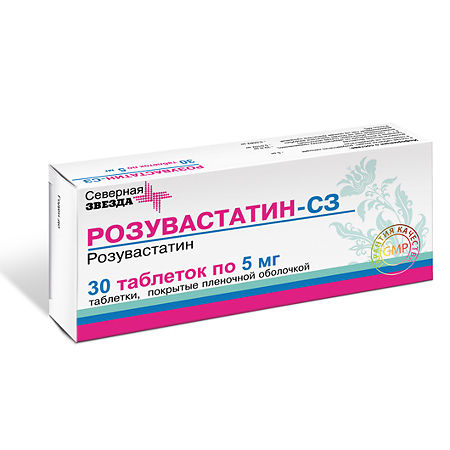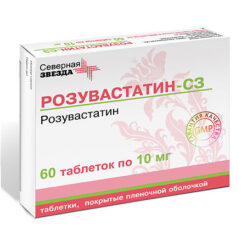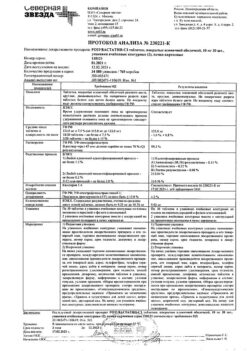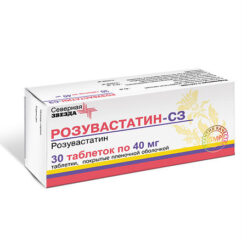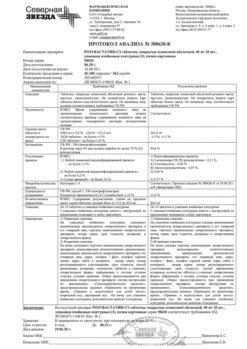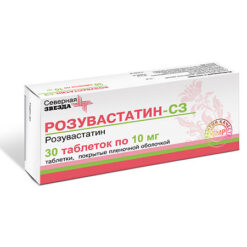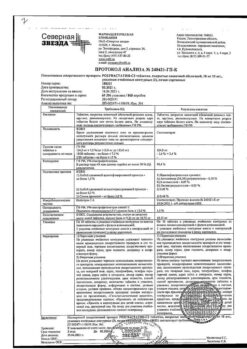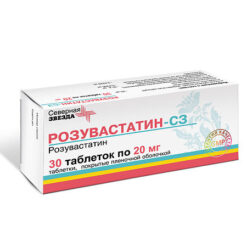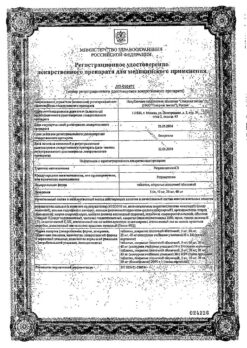No products in the cart.
Rosuvastatin-SZ, 5 mg 30 pcs
€7.42 €6.49
Description
Pharmacodynamics
Mechanism of action
Rosuvastatin is a selective, competitive inhibitor of HMG-CoA reductase, an enzyme that converts Z-hydroxy-Z-methylglugaryl coenzyme A to mevalonic acid, a precursor of cholchterol. The main target of rosuvastatin action is the liver, where the synthesis of cholesterol (cholesterol) and catabolism of low-density lipoproteins (LDL) takes place.
Rosuvastatin increases the number of “hepatic” LDL receptors on the surface of cells, increasing the capture and catabolism of LDL, which in turn leads to inhibition of synthesis of very low density lipoproteins (VLDL), thereby reducing the total amount of LDL and VLDL.
Pharmacodynamics
. Rosuvastatin-CZ reduces elevated concentrations of LDL cholesterol (LDL-C), total cholesterol, triglycerides (TG), increases concentrations of high-density lipoprotein cholesterol (HDL-C) and decreases concentrations of apolipoprotein B (ApoB), non-LDL-C, HDL-C, TG-LDL-C and increases the concentration of apolipoprotein A-1 (ApoA-1), reduces the ratio of HDL-C/HD-LDL, total HC/HDL and non-HDL-C/HD-LDL and the apoB/apoA-1 ratio.
Therapeutic effect is developed within 1 week after the start of therapy with Rosuvastatin-CS, after 2 weeks of treatment reaches 90% of the maximum possible effect. Maximum therapeutic effect is usually reached by the 4th week of therapy and is maintained with regular use of the drug.
Rosuvastatin-SZ is effective in adult patients with hypercholesterolemia with or without hypertriglyceridemia regardless of race, sex or age, including patients with diabetes mellitus and familial hypercholesterolemia.
In 80% of patients with hypercholesterolemia of type HA and Hb according to Fredrickson (mean baseline concentration of LDL-C about 4.8 mmol/L) with the use of the drug in dose of 10 mg LDL-C concentration reaches values less than 3 mmol/L.
In patients with heterozygous familial hypercholesterolemia receiving Rosuvastatin-CS at a dose of 20-80 mg, positive dynamics of lipid profile parameters are observed. After titration to a daily dose of 40 mg (12 weeks of therapy), there is a decrease in LDL-C concentration by 53%. In 33% of patients the concentration of LDL-C is less than 3 mmol/l.
In patients with homozygous familial hypercholesterolemia receiving Rosuvastatin-CS in doses of 20 mg and 40 mg the mean decrease of LDL-C concentration is 22%.
In patients with hypertriglyceridemia with an initial TG concentration of 273 to 817 mg/dp who received Rosuvastatin-SZ in doses of 5 mg to 40 mg once daily for 6 weeks, plasma TG concentrations were significantly reduced.
Additive effect is noted in combination with fenofibrate with regard to triglycerides and with nicotinic acid in lipid-lowering doses with regard to HDL-C (see also section “Special indications”).
Based on the results of clinical studies, patients with significant hypercholesterolemia and high risk of cardiovascular disease (CVD) should be prescribed the dose of Rosuvastatin-CZ 40 mg.
The results of a clinical study (Rationale for Statins in Primary Prevention: An Interventional Study to Evaluate Rosuvastatin) showed that Rosuvastatin significantly reduced the risk of cardiovascular complications. Pharmacokinetics Absorption and distribution
Maximum plasma concentration of rosuvastatin is reached approximately 5 hours after oral administration. Absolute bioavailability is approximately 20%. Rosuvastatin is metabolized mainly by the liver, which is the main site of cholesterol synthesis and metabolism of LDL-C. The volume of distribution of rosuvastatin is approximately 134 l. About 90% of rosuvastatin is bound to plasma proteins, mainly to albumin.
Metabolism
It is subject to limited metabolism (about 10%). Rosuvastatin is a non-core substrate for metabolism by enzymes of cytochrome P450 system. The main isoenzyme involved in metabolism of rosuvastatin is CYP2C9 isoenzyme. CYP2C19, CYP3A4 and CYP2D6 isoenzymes are less involved in metabolism.
The main identified metabolites of rosuvastatin are N-desmethylrosuvastagin and lactone metabolites. N-desmethylrosuvastatin is about 50% less active than rosuvastatin, lactone metabolites are pharmacologically inactive. More than 90% of the pharmacological activity for inhibition of circulating HMG-CoA reductase is provided by rosuvastatin, the rest by its metabolites.
The elimination half-life does not change with increasing drug dose. The geometric mean plasma clearance is approximately 50 L/hour (coefficient of variation 21.7%). As in the case of other HMG-CoA reductase inhibitors, the membrane cholesterol transporter, which plays an important role in hepatic elimination of rosuvastatin, is involved in the “hepatic” uptake of rosuvastatin.
Linearity
The systemic exposure of rosuvastatin increases in proportion to the dose. Pharmacokinetic parameters do not change with daily administration.
Particular patient populations.
Age and sex
Percentage and age have no clinically significant effect on the pharmacokinetics of rosuvastatin. Ethnic groups
Pharmacokinetic studies have shown approximately two-fold increase in median AUC (area under the curve “concentration-time”) and Stah (maximum concentration in blood plasma) of rosuvastatin in patients of Mongoloid race (Japanese, Chinese, Filipino, Vietnamese and Koreans) compared to Caucasians; in Indians median AUC and Stah increase 1.3-fold was shown. Pharmacokinetic analysis showed no clinically significant differences in pharmacokinetics among Caucasians and non-Hispanics.
Renal failure
In patients with mild to moderately severe renal failure, plasma concentrations of rosuvastatin or N-desmethylrosuvastatin do not change significantly. In patients with severe renal insufficiency (creatinine clearance (CK) less than 30 ml/min) the plasma concentration of rosuvastatin is 3 times higher, and N-desmethylrosuvastatin concentration is 9 times higher than in healthy volunteers. Plasma concentrations of rosuvastatin were approximately 50% higher in patients on hemodialysis than in healthy volunteers.
Hepatic failure
In patients with various stages of hepatic failure, there was no increase in the half-life of rosuvastatin in patients with a Child-Pugh score of 7 or lower. Two patients with Child-Pugh scores 8 and 9 showed at least 2-fold increase in half-life. There is no experience with rosuvastatin in patients with more than a Child-Pugh score of 9.
Genetic polymorphisms
HMG-CoA reductase inhibitors, including rosuvastatin, bind to the transport proteins OATP1B1 (organic anion transport polypeptide involved in statin capture by hepatocytes) and BCRP (efflux transporter), In carriers of SLC01B1 (OATP1B1) genotypes C.521CC and ABCG2 (BCRP) with 421AA had 1.6 and 2.4-fold increased exposure (AUC) to rosuvastatin, respectively, compared with carriers of SLC01B1 C.521T and ABCG2 C.421CC genotypes.
Indications
Indications
Fredrickson primary hypercholesterolemia (type H, including familial heterozygous hypercholesterolemia) or mixed hypercholesterolemia (type Hb) as an adjunct to diet when diet and other non-medicinal treatments (e.g., exercise, weight loss) are insufficient,
familial homozygous hypercholesterolemia as an adjunct to diet and other lipid-lowering therapy
Familial homozygous hypercholesterolemia as an adjunct to diet and other lipid-lowering therapy (e.g., LDL-apheresis), or in cases where such therapy is not sufficiently effective,
Hypertriglyceridemia (Fredrickson type IV) as an adjunct to diet.
To slow the progression of atherosclerosis as an adjunct to diet in patients who are indicated for therapy to reduce total cholesterol and LDL-C concentrations.
Primary prevention of major cardiovascular complications (stroke, infarction, arterial revascularization) in adult patients without clinical signs of CHD, but with an increased risk of its development (age over 50 years for men and over 60 years for women, increased concentration of C-reactive protein (more than 2 mg/L) in the presence of at least one additional risk factor, such as hypertension, low HDL-C, smoking, family history of early-onset CHD).
Active ingredient
Active ingredient
Composition
Composition
Active ingredient: calcium rosuvastatin in terms of rosuvastatin – 5 mg.
Excipients:
core – lactose monohydrate (milk sugar) – 32.9 mg; calcium hydrophosphate dihydrate – 5.0 mg; guidone (polyvinylpyrrolidone medium molecular) – 3.0 mg; sodium crharmellose (lrimellose) – 3.0 mg; sodium stearyl fumarate – 0.8 mg; colloidal silica (aerosil) – 0.3 mg; microcrystalline cellulose – 30.0 mg;
coating – Ogadray II (polyvinyl alcohol, partially hydrolyzed – 0.88 mg; Macrogol (polyethylene glycol) 3350 – 0.247 mg; talcum powder – 0.4 mg; titanium dioxide E171 – 0.3834 mg; soy lecithin E 322 – 0.07 mg; aluminum varnish based on indigo carmine dye – 0.0012 mg; aluminum varnish based on azorubin dye – 0.0102 mg; aluminum varnish based on crimson dye [Ponzo 4R] – 0.0082 mg).
How to take, the dosage
How to take, the dosage
Orally, do not chew or crush the tablet, swallow it whole by pouring water on it. The drug can be taken at any time of the day regardless of meals.
People should start a standard hypocholesterolemic diet before starting therapy with Rosavastatin-SZ and continue this diet during treatment.
The dose of the drug should be adjusted individually depending on the goals of therapy and the therapeutic response to treatment, taking into account current recommendations for target lilidyl concentrations.
The recommended starting dose for patients starting to take the drug or switching from other HMG-CoA reductase inhibitors should be 5 mg or 10 mg of Rosuvastatin-CZ once daily. When choosing the initial dose, individual cholesterol content should be guided and possible risk of cardiovascular complications should be taken into account, as well as the potential risk of side effects should be assessed.
If necessary, the dose may be increased to a higher dose after 4 weeks (see section “Pharmacodynamics”).
Because of the possible development of side effects when taking a dose of 40 mg, compared to lower doses of the drug (see section “Side Effects”). Due to possible development of side effects of 40 mg dose compared to lower doses of the drug (see section “Side effects”), dose increase to 40 mg, after additional dosing above the recommended initial dose during 4 weeks of therapy, may be conducted only in patients with severe hypercholesterolemia and with high risk of cardiovascular complications (especially in patients with familial hypercholesterolemia), in whom the desired therapy result was not reached while taking 20 mg dose, and who will be under specialist supervision (see section “Special indications”). We recommend especially close monitoring of patients receiving the drug in a dose of 40 mg.
The 40 mg dose is not recommended for patients who have not previously seen a physician. After 2-4 weeks of therapy and/or when increasing the dose of Rosuvastatin-SZ, lipid metabolism should be monitored (if necessary, a dose adjustment is required). Older patients No dose adjustment is required.
Patients with renal impairment
In patients with mild to moderate renal impairment, no dose adjustment is required. In patients with severe renal failure (CKD less than 30 ml/min) the use of Rosuvastatin-SZ is contraindicated. The use of the drug in dose of 40 mg is contraindicated in patients with moderate renal impairment (CK 30-60 ml/min) (see sections “Special indications” and “Pharmacodynamics”).
Patients with moderate renal dysfunction should receive a starting dose of 5 mg
Patients with hepatic impairment
Rosuvastatin-CS is contraindicated in patients with active hepatic disease (see “Contraindications. Contraindications),
Particular populations. Ethnic groups
When studying pharmacokinetic parameters of rosuvastatin in patients belonging to different ethnic groups, an increased systemic concentration of rosuvastatin was noted among Japanese and Chinese (see section “Special indications”).
This fact should be considered when prescribing Rosuvastatin-SZ for these groups of patients When prescribing doses of 10 mg and 20 mg the recommended starting dose for patients of mongoloid race is 5 mg. A dose of 40 mg is contraindicated in patients of Mongoloid race (see “Contraindications”),
Hydetic polymorphism
In carriers of SLCOIBI (OATP1B1) genotype C.521CC and ABCG2 (BCRP) C.421AA had increased exposure (AUC) to rosuvastatin compared with SLCOIBI C.521TT and ABCG2 C.421CC genotypes carriers. For C.521CC or C.421AA genotype carriers the recommended maximum dose of Rosuvastatin-CZ is 20 mg once daily (see sections “Pharmacokinetics”, “Precautions” and “Interaction with other medicinal products”).
Patients with predisposition to myopathy
The drug is contraindicated in a dose of 40 mg in patients with factors that may indicate a predisposition to myopathy (see Contraindications). When prescribing doses of 10 mg and 20 mg the recommended starting dose for this group of patients is 5 mg (see section “Contraindications”),
Companion therapy
Rosuvastatin binds to various transport proteins (in particular to OATP1B1 and BCRP). When co-administration of Rosuvastatin-CZ with drugs (such as cyclosporine, some HIV protease inhibitors, including the combination of ritonavir with atazanavir, lopinavir and/or tipranavir) that increase the plasma concentration of rosuvastatin through interaction with transport proteins, the risk of myopathy (including rhabdomyolysis) may increase (see sections “Precautions” and “Interaction with other medicinal products”).
In such cases, alternative therapy or temporary discontinuation of Rosuvastatin-CZ should be evaluated. If the use of the above drugs is necessary, the benefit-risk ratio of concomitant therapy with Rosuvastatin-SZ should be assessed and the possibility of reducing its dose should be considered (see section “Interaction with other medicinal products”).
Interaction
Interaction
Special Instructions
Special Instructions
Use with caution in the presence of risk factors for rhabdomyolysis (including renal failure, hypothyroidism, personal or family history of hereditary muscle disease and previous history of muscle toxicity when using other HMG-CoA reductase inhibitors or fibrates), chronic alcoholism, in patients over 65 years of age, with a history of liver disease, sepsis, arterial hypotension, extensive surgery, trauma, severe metabolic endocrine or electrolyte disorders, uncontrolled epilepsy, in persons of Asian origin (Chinese, Japanese).
The therapy should be discontinued if the CPK level is significantly increased (more than 5 times the IGN level) or if muscle symptoms are severe and cause daily discomfort (even if the CPK level is 5 times less than the IGN level).
When using rosuvastatin at a dose of 40 mg, it is recommended to monitor renal function parameters.
In most cases proteinuria decreases or disappears during therapy and does not indicate acute or progressive existing renal disease.
An increase in myositis and myopathy has been reported in patients taking other HMG-CoA reductase inhibitors in combination with fibrin acid derivatives (including gemfibrozil), cyclosporine, nicotinic acid, azole antifungals, protease inhibitors and macrolide antibiotics. Gemfibrozil increases the risk of myopathy when concomitantly prescribed with some HMG-CoA reductase inhibitors. Thus, concomitant administration of rosuvastatin and gemfibrozil is not recommended. The risk/benefit ratio of co-administration of rosuvastatin and fibrates or niacin should be carefully weighed.
Liver function tests are recommended before therapy and 3 months after the start of therapy. Rosuvastatin should be discontinued or the dose should be reduced if serum transaminase activity is 3 times greater than BHN.
In patients with hypercholesterolemia due to hypothyroidism or nephrotic syndrome, therapy for underlying diseases should be performed before starting treatment with rosuvastatin.
Impact on driving and operating machinery
Patients should be aware that dizziness may occur during therapy when engaged in potentially hazardous activities.
Contraindications
Contraindications
For the drug Rosuvastatin-SZ in a daily dose of 5 mg. 10 mg and 20 mg:
hypersensitivity to rosuvastatin or any of the components of the drug
Lactose intolerance, lactase deficiency or glucose-galactose malabsorption (the drug contains lactose)
children under 18 years
active phase liver disease, including persistent elevation of serum transaminase activity and any increase in serum transaminase activity (more than 3 times the upper limit of normal)
severe renal failure (CK less than 30 ml/min.)
myopathy
concomitant administration of cyclosporine
in women: pregnancy; period of breastfeeding, lack of adequate methods of contraception
increased concentration of creatine phosphokinase (CPK) in blood more than 5 times the upper limit of normal
co-use with HIV protease inhibitors
Patients who are prone to developing myotoxic complications For Rosuvastatin-SZ at a daily dose of 40 mg:
hypersensitivity to rosuvastatin or any of the components of the drug
Lactose intolerance, lactase deficiency or glucose-galactose malabsorption (the drug contains lactose)
Lactose intolerance, lactase deficiency or glucose-galactose malabsorption
childhood under 18 years
concurrent administration of cyclosporine
in women: pregnancy, breastfeeding period, lack of adequate methods of contraception
increased blood creatine phosphokinase (CPK) concentrations more than 5 times the upper limit of normal
co-administration with HIV protease inhibitors
moderate to severe renal failure (CKD less than 60 ml/min.)
Hepatic disease in the active phase, including persistent elevation of serum transaminase activity and any increase in serum transaminase activity (more than 3 times the upper limit of normal) in patients with risk factors for myopathy/rhabdomyolysis, namely:
hypothyroidism
myotoxicity with a history of taking other HMG-CoA reductase inhibitors or fibrates
/li>
excessive alcohol consumption
conditions that may lead to increased plasma concentrations of rosuvastatin
concomitant administration of fibrates
Myopathy
personal or family history of muscle disease
Mongoloid patients
WARNING
For Rosuvastatin-SZ in daily doses of 5 mg 10 mg and 20 mg:
Presence of risk of myopathy/rhabdomyolysis – renal failure, hypothyroidism, personal or family history of hereditary muscle disease, and prior history of muscle toxicity with other HMG-CoA reductase inhibitors or fibrates; excessive alcohol consumption; age over 65 years; conditions with increased plasma concentrations of rosuvastatin; race (Mongoloid race); concomitant administration with fibrates (see section “Pharmacokinetics”); history of liver disease; sepsis; arterial hypotension; major surgical interventions, trauma, severe metabolic, endocrine or electrolyte disorders or uncontrolled seizures.
Simultaneous use with colchicine and with ezetimibe (see section “Interaction with other medicinal products”).
For the drug Rosuvastatin-CZ in a daily dose of 40 mg:
Mild renal impairment (CK greater than 60 mL/min); age over 65 years; history of liver disease; sepsis; arterial hypotension; extensive surgery, trauma, severe metabolic, endocrine or electrolyte disorders or uncontrolled seizures.
Simultaneous use with colchicine and with ezetimibe (see section “Interaction with other medicinal products”).
Patients with hepatic impairment
There is no data or experience with the drug in patients with more than a Child-Pugh score of 9 (see sections “Pharmacodynamics” and “Special Precautions”).
Side effects
Side effects
Side effects observed when taking Rosuvastatin-CZ are usually mild and go away on their own. As with other HMG-CoA reductase inhibitors, the incidence of side effects is mainly dose-dependent. The incidence of adverse effects is as follows: frequently (> 1/100, <1/10); infrequently (> 1/1000, <1/100); rarely (> 1/10000, < 1/1000); very rarely (< 1/10000), unspecified frequency (cannot be calculated from the available data).
Immune system
Rare: hypersensitivity reactions, including angioedema.
Endocrine system
Often: type 2 diabetes mellitus
Central nervous system disorders
Often: headache, dizziness
Digestive tract side
Often: constipation, nausea, abdominal pain
Rarely: pancreatitis
Skin disorders
Infrequently: skin itching, rash, urticaria
Musculoskeletal disorders
Often: myalgia
Rarely: myopathy (including myositis), rhabdomyolysis Other
Often: Asthenic syndrome Urinary system side
Patients receiving Rosuvastatin-CZ may show proteinuria. Changes in the amount of protein in the urine (from no or trace amounts to ++ or greater) are seen in less than 1% of patients receiving 10 to 20 mg of the drug and in approximately 3% of patients receiving 40 mg of the drug.
Significant changes in the amount of protein in the urine have been observed with the 20 mg dose. In most cases, proteinuria decreases or disappears during therapy and does not indicate the onset of acute or progressive existing renal disease.
Musculoskeletal disorders
The following musculoskeletal effects have been reported with Rosuvastatin-CZ at all doses and, in particular, with doses greater than 20 mg: Myalgia, myopathy (including myositis), in rare cases, rhabdomyolysis with or without acute renal failure.
Dose-dependent increase in creatine phosphokinase (CPK) activity has been observed in a small number of patients taking rosuvastatin. In most cases it was insignificant, asymptomatic and temporary. In case of an increase in CPK activity (more than 5 times the upper limit of normal), therapy should be suspended (see section “Special Precautions”)
Hepatic disorders
In a small number of patients on rosuvastatin a dose-dependent increase in hepatic transaminases has been observed. In most cases it is mild, asymptomatic and temporary.
Laboratory indices
When using Rosuvastatin-SZ the following changes in laboratory indices were also observed: increase in glucose concentration, bilirubin, activity of gamma-glutamyl transpeptidase, alkaline phosphatase, thyroid dysfunction. Post-marketing use
The following side effects have been reported in the post-marketing use of Rosuvastatin-SZ:
Hematopoietic system side effects
Unspecified frequency: thrombocytopenia
Gastrointestinal tract side effects
Very rare: jaundice, hepatitis
Rarely: increased activity of “liver” transaminases
Unspecified frequency: Diarrhea
Musculoskeletal disorders
Very rare: arthralgia
Unspecified frequency: Immune-mediated necrotizing myopathy
Central nervous system disorders
Very rare: polyneuropathy, memory loss
Respiratory system disorders
Unspecified frequency: cough, shortness of breath
Urinary system disorders
Very rare: Hematuria
Skin and subcutaneous fat disorders Unspecified frequency: Stevens-Johnson syndrome Reproductive system and breast disorders Unspecified frequency: gynecomastia Other
Unspecified frequency: peripheral edema.
The following side effects have been reported with some statins: depression, sleep disturbances, including insomnia and “nightmares,” sexual dysfunction. Single cases of interstitial lung disease have been reported, especially with long-term use of the drugs (see section “Cautions”).
Overdose
Overdose
Pregnancy use
Pregnancy use
Rosuvastatin-SZ is contraindicated in pregnancy and during breastfeeding. Women of reproductive age should use adequate methods of contraception. Since cholesterol and other products of cholesterol biosynthesis are important for fetal development, the potential risk of HMG-CoA reductase inhibition exceeds the benefit of using the drug in pregnant women.
If pregnancy occurs during therapy, the drug should be discontinued immediately.
There are no data on excretion of rosuvastatin with the breast milk, therefore during breast-feeding the drug should be discontinued (see section “Contraindications”).
Similarities
Similarities
Additional information
| Shelf life | 3 years. Do not use after the expiration date printed on the package. |
|---|---|
| Conditions of storage | In a dry, light-protected place at a temperature not exceeding 25 °C. |
| Manufacturer | North Star NAO, Russia |
| Medication form | pills |
| Brand | North Star NAO |
Other forms…
Related products
Buy Rosuvastatin-SZ, 5 mg 30 pcs with delivery to USA, UK, Europe and over 120 other countries.

